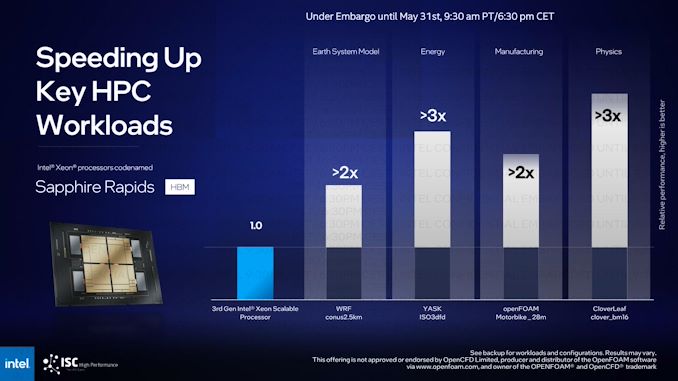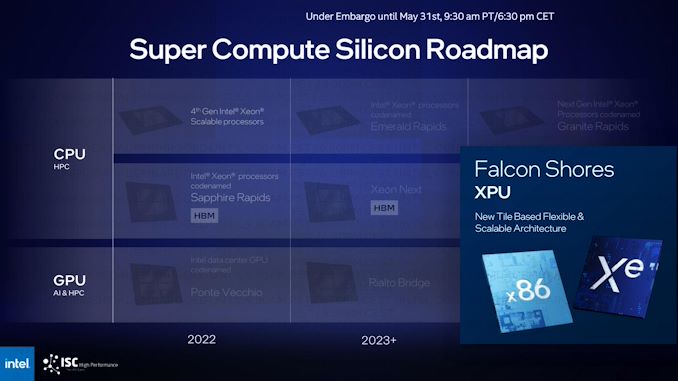Intel Showcases Sapphire Rapids Plus HBM Xeon Performance at ISC 2022
by Ryan Smith on May 31, 2022 12:30 PM EST
Alongside today’s disclosure of the Rialto Bridge accelerator, Intel is also using this week’s ISC event to deliver a brief update on Sapphire Rapids, the company’s next-generation Xeon CPU which is shipping later this year. While Intel has been beating the drum for their forthcoming, 4th Generation Xeon Scalable chip for a while, we have yet to hear anything of significance about its expected performance – particularly in the HPC space. So ahead of its formal launch a bit later this year, Intel is finally talking a bit about the expected performance of the HBM-equipped version of the chip, which is aimed in particular at the HPC/supercomputing crowd.
Intel’s first tiled Xeon processor, Sapphire Rapids is also Intel’s first CPU to offer optional on-chip HBM memory, which is being dubbed Sapphire Rapids Plus HBM. The addition of 64GB of HBM2e makes it a fairly complex and expensive chip, but also one with access to far more memory bandwidth than any x86 CPU before it. As a result, the chip is of particular interest to a subset of the high-performance compute community, as it offers an alternative route for workloads that aren’t suitable for GPUs, but still need access to vast amounts of memory bandwidth.
As part of their ISC presentation today, Intel is releasing two slides with performance figures for the HBM version of Sapphire Rapids (Sapphire Rapids Plus HBM). The idea here is to show off the combination of architecture improvements – and in particular, the dedicated accelerator blocks – combined with using 64GB of HBM2e memory to keep those blocks well fed. The pre-production processors are being compared to Intel’s Xeon Platinum 8380 (Ice Lake-SP) chips.
Bearing in mind that these are going to be cherry-picked performance figures, Intel is seeing anywhere between a 2x speed-up in things like the WRF weather forecasting model, to over a 3x improvement for the CloverLeaf Euler equation solver. Both of which are somewhat narrow use cases, but important ones for the HPC market segment.
Sapphire Rapids Plus HBM is due to be released alongside the rest of the Sapphire Rapids family later this year. According to Intel’s current roadmaps, it is due for a successor in the 2023 timeframe, before the entire HBM-equipped Xeon lineup is due to be rolled into the Falcon Shores XPU in 2024.


















21 Comments
View All Comments
noobmaster69 - Tuesday, May 31, 2022 - link
Claiming >2x and >3x performance vs Xeon 8380 systems sounds great right up until you realize that AMD’s Milan platform absolutely trounces these same Xeon parts in every non-AVX512 workload. The real question is how will they stack up against Genoa as it’ll be released around the same time?Lakados - Tuesday, May 31, 2022 - link
Trounces yea but only by ~50%, so if they are offering 2-3x performance increases that would put it very well ahead so the real question is how much of a performance increase do the new EPYC’s get.lemurbutton - Wednesday, June 1, 2022 - link
Who cares about Epyc? Amazon's Graviton3 and Ampere's massive chips are beating the pants off both Epyc and Xeon in cost/performance and is either straight up faster or slightly slower in raw performance.AdrianBc - Wednesday, June 1, 2022 - link
Both Amazon's and Ampere's chips cannot beat in cost/performance any other CPU, because their price is an infinity, if you are a small business or an individual, because nobody will sell you any of them.There are a few server CPUs with ARM cores that are available at retail, e.g. from Broadcom or NXP, but those have worse performance per dollar than many AMD or Intel chips.
The only CPUs with ARM cores which have better performance per dollar than any AMD or Intel chip are those at the lowest endpoint of the performance range, when the entire server must cost under $200, or maybe at most up to $300, and where Chinese CPUs with ARM cores, e.g. Rockchip RK3588 or RK3568, have an unbeatable performance per dollar.
In a year or two, things might change a lot and there might appear good server options with Armv9 CPUs, but we are not there yet.
TomWomack - Wednesday, June 1, 2022 - link
They can absolutely beat in cost/performance other CPUs in completely meaningful ways - run your job on c7g and c6i and compare whether you are getting more performance from $0.284/hr c7g.4xlarge or $0.2822/hr c6i.4xlarge.AdrianBc - Wednesday, June 1, 2022 - link
Using those instances is a good choice for people who do not know how to select and manage their own servers, but those who do know can achieve a much lower cost than when using a cloud.Regarding the cost of the cloud instances, we cannot know how well the prices offered to customers reflect the true cost of buying and operating such servers.
For a large company like Amazon, not sharing their profits with a middleman like AMD or Intel can be a sufficient financial advantage to make them use their own CPUs, even if they do not have any technical advantage.
nandnandnand - Wednesday, June 1, 2022 - link
"where Chinese CPUs with ARM cores, e.g. Rockchip RK3588 or RK3568, have an unbeatable performance per dollar."You are massively overhyping their price/performance.
AdrianBc - Wednesday, June 1, 2022 - link
RK3588, with quadruple Cortex-A76, has the same speed as the Intel 4-core Jasper Lake Pentium Silver or Celeron CPUs, but a complete computer with RK3588, at $150 - $300 is about $100 cheaper than a similarly-equipped computer with Jasper Lake.The cheapest computers with an AMD Zen or Intel Core CPUs are about 50% faster in single-thread than Cortex-A76, but their price is at least double.
Neither Intel Jasper Lake (Pentium N6005 / Celeron N5105) nor RK3588 can be recommended as personal computers, but for cheap servers, e.g. routers or NAS, or for home theaters, they are OK.
kgardas - Thursday, June 2, 2022 - link
Ampere is freely purchasable on common market. So if you like, you can use it. On the other hand I'm afraid their cache arch will not make them competitive for HPC job in comparison with neither intel nor amd.Silma - Wednesday, June 1, 2022 - link
That's actually not true.Given the almost similar pricing between Graviton3 instances and AMD instances on AWS, the Graviton3 appeal will be of little interest to most organizations.